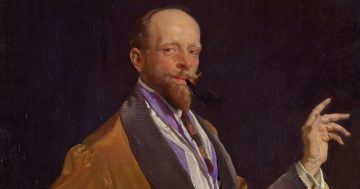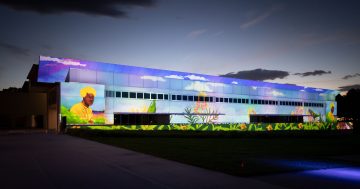
National Portrait Gallery co-curator Emma Kindred (left) with artist Joan Ross, NPG director Bree Pickering and co-curator Coby Edgar. Photo: NPG.
Sometimes all we want from art is to enjoy it. To look at in on a wall in a gallery and take it all in. If we’re lucky, we can see something attuned to what the artist does. Other times, it’s enough to enjoy their rendering because it triggers something in our mind, something good.
Then there’s the work of Joan Ross, where the audience can’t but help question themselves and where we come from.
In her unique way, the contemporary artist has gone through the National Portrait Gallery’s (NPG) collection, choosing works that she places alongside her signature practice – transforming scenes from colonial artworks. The result? A dynamic and vibrant exhibition, Those trees came back to me in my dreams, that invites the audience to question history’s stories.
Speaking after her exhibition opened at the NPG last week, Ms Ross said she felt privileged looking through vaults in the Canberra gallery with her exhibition co-curators Emma Kindred and Coby Edgar for traditional works to be displayed alongside her digital “cut and paste” pieces.
Famous works included Captain James Cook and William Bligh by colonial artist John Webber along with Thomas Phillips’ portrait of botanist Joseph Banks.
Ms Ross’s works, next to the colonial masters, don’t ask why you question our history, rather they appear to demand it – and that’s exactly what the artist seems to want.
“When they took me into the gallery vaults, it was amazing to see these works,” she said. “I ended up pulling out too many Cooks and Banks which were both interesting and disturbing to me,” she said. “They were disturbing because they were all white colonial men, you could literally see the superiority in their eyes.
“I suppose I have a love-hate relationship with these colonial works, but I suppose I couldn’t do what I do if I didn’t think like that.”







Of the exhibition’s title and 2024 work of the same name, Ms Ross said she was interested in shifting the narrative and re-imagining the past.
“I am particularly interested in imagining that this man who came to Tasmania and cut all the trees down in an act of total disregard and insensitivity for the original inhabitants, has later in life realised what an enormous mistake he has made, that he has built his empire on greed,” she said.
Ms Ross said the exhibition featured about 50 of her works alongside pieces from the NPG collection.
“We started working on it back in March,” she said. “Started looking at what would work together.

Joan Ross’s work, The beginning of greed, illustrates two forms of fishing. Photo: NPG.
“Some of the pieces were in my storage unit, some in the gallery, other works were pulled in from loans, others I had printed especially for this show. ”
Ms Ross said works in the exhibition were “only the tip of the iceberg” when it came to what she did, with some pieces dating back to 2006.
She said she loved working with the curators who “got” that she loved to be “fake” in her work.
“As an artist, I have licence to go back in time – like in the work where you can see the beginning of greed with a few people fishing and then you see people with a glut of salmon – you don’t need words for that.”

The title piece in Joan Ross’s new show at the NPG, Those trees came back to me in my dreams, 2024. Photo: NPG.
Describing herself as a “driven person”, Ms Ross said: “I’ve only ever been good at art.
“Yes, it can be hard to survive but I suppose I’m here because it’s what my best quality is.
“For me, it’s always been about communicating and educating. I want kids to come through this exhibition and ask questions about what they see, I want them to open up discussion.
“Some of the works in this exhibition are warning works. Where you can see the insensitivity by some people more than others – be careful of what you’re doing now because you may regret it later – like what we’ve done to the environment.”
Ms Ross was pleased the show would be on until February next year. “It’s a big show with a lot in it for people to see so I’m glad there will be enough time for them to see it and then maybe go back and see something else in it again.”
Those trees came back to me in my dreams, an exhibition by Joan Ross, is on at the National Portrait Gallery, Canberra, until 2 February, 2025. Free exhibition. Open daily.





















